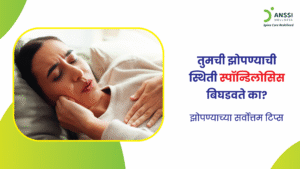Spondylosis is a degenerative condition affecting the spine, most commonly in the cervical (neck) or lumbar (lower back) regions. It typically occurs due to ageing but can also result from repetitive stress or poor posture. Many people with spondylosis experience pain, stiffness, and reduced mobility, especially in the morning.
While medication, therapy, and lifestyle changes help manage symptoms, one often overlooked factor is how you sleep. Your sleep posture can significantly influence your spinal health. In fact, a poor sleeping position may silently worsen your condition every night.
Let’s explore the connection between spondylosis and sleep, highlight the worst sleeping positions to avoid, and discuss practical tips for sleeping better with this spinal condition.
The Connection Between Spondylosis and Sleep
Sleep is a time when your body heals and regenerates. But if your spine is not properly aligned while sleeping, it can lead to added pressure on already-degenerated discs and joints. This can worsen nerve compression, cause morning stiffness, and even reduce the quality of sleep, making pain and inflammation worse during the day.
Cervical spondylosis sufferers may wake up with neck stiffness, while those with lumbar spondylosis often feel lower back discomfort after a night of poor support. This is why optimising your sleeping posture is a critical step in managing spondylosis symptoms effectively.
The Worst Sleeping Positions for Spondylosis
Try to avoid the following if you are suffering from spondylosis.
Sleeping on the Stomach
This is widely considered the worst position for people with spondylosis. When you lie on your stomach, your neck is turned to one side for hours, straining the cervical spine. At the same time, your lower back is forced into an unnatural arch, adding stress to the lumbar spine.
Twisting the Spine or Hips While Sleeping
Many people unknowingly twist their bodies while sleeping, especially when lying on their side without proper support. This can rotate the pelvis and spine in opposite directions, which increases mechanical stress and leads to inflammation and discomfort.
Using the Wrong Pillow or Too Many Pillows
A pillow that is too high or too flat can cause misalignment of your neck. Similarly, stacking multiple pillows can push your head forward and put stress on the cervical vertebrae. Both extremes contribute to morning neck pain and poor spinal alignment.
Best Sleeping Positions and Tips for Spondylosis
Try to implement the following in your sleep routine.
1. Sleeping on Your Back with a Pillow Under the Knees
This position helps maintain the spine’s natural curvature. Placing a pillow under your knees reduces pressure on the lower back and prevents hyperextension of the lumbar spine. Make sure your neck is supported with a cervical pillow that keeps your head aligned with the spine.
2. Side Sleeping with a Pillow Between the Knees
This is one of the safest positions for people with spondylosis. Keeping a pillow between the knees prevents the upper leg from twisting the spine and keeps the hips aligned. It reduces tension in the lumbar and pelvic region. Use a firm pillow to support your neck without bending it unnaturally.
3. Choose the Right Mattress
A medium-firm mattress is ideal for maintaining spinal alignment. A mattress that is too soft can cause your body to sink in unevenly, distorting your posture. Conversely, a mattress that is too hard may not accommodate the natural curves of the body. Opt for orthopaedic or memory foam mattresses for consistent support.
4. Maintain a Consistent Sleep Schedule
Your body’s circadian rhythm can be regulated by going to bed and waking up at the same time every day. Deep, restorative sleep helps reduce inflammation and muscle tightness. Avoid heavy meals, screen time, and caffeine before bedtime to ensure quality sleep.
5. Support the Neck and Lower Back
Use ergonomic cervical pillows for neck support. For added lumbar support, consider a small rolled towel placed under your lower back if needed. These minor adjustments can significantly improve your comfort and spinal health during the night.
When to Seek Professional Help
If you’re experiencing consistent neck or back pain that interferes with your sleep, it’s important not to ignore the symptoms.
Signs that warrant medical attention include:
- Frequent morning stiffness or spasms
- Tingling or numbness in the arms or legs
- Headaches starting from the neck
- Difficulty turning your neck or bending your back
These may indicate worsening spondylosis or nerve compression. A spine specialist or physiotherapist can evaluate your condition and recommend appropriate interventions.
Non-Surgical Treatments for Better Sleep and Spine Health
For many people with spondylosis, non-surgical approaches offer lasting relief and better sleep.
These include:
- Physiotherapy: Targeted exercises can strengthen the muscles supporting the spine and improve posture. A physiotherapist can also teach sleeping positions that prevent flare-ups.
- Posture Correction: Daytime posture has a direct impact on nighttime alignment.
- Non-Surgical Spinal Decompression Treatment: A non-invasive treatment that gently stretches the spine to relieve pressure on spinal discs and nerves. It helps restore disc health and improve circulation, leading to reduced pain and better sleep.
About ANSSI:
ANSSI Wellness focuses on improving the quality of life for patients suffering from spinal issues, aiming to provide relief where other conventional treatments have failed. Through advanced non-surgical spinal decompression treatment, ANSSI is committed to helping patients avoid surgery and recover in a safe, effective, and compassionate environment.
Connect with ANSSI Wellness on LinkedIn, Instagram, and Facebook for expert guidance.



